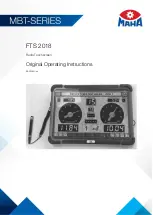
120.01 * 4.167 * 0
°
+120.01 * 4.167 * COS 0
°
+120.01 * 4.167 * COS 0
°
or, 500.0816 + 500.0816 + 500.0816 = 1500.24 Watts
For this example, let's assume the measured output current from the transducer is 20.2
mA dc. Based on a Max. value of 20 mA equals 1500 Watts, the displayed
Watts
in the
Transducer Output
section of the
Transducer Test Screen
should read
1515.0 Watts
The
Accuracy
displayed in the
Transducer Output
section would be equal to the
following,
(1515 - 1500.24 / 1500.24) * 100 = % accuracy or
0.984
%
If this were a 0.5 % transducer, then the firmware would compare the accuracy values
between the Setting Screen and the Test Screen and would display
Test Failed
in the
Transducer Output
section of the test screen.
If the user adjusts the phase angle in the lagging direction by 30
°
, then the Watts output
changes.
Using the formula,
V1 * I1 * (COS
∅
) + V2 * I2 * (COS
∅
) + V3 * I3 * (COS
∅
) = Total Watts
Where
∅
is the incremental angular change of 30
°
between V1 and I1, V2 and I2, and
V3 and I3 etc. ,
then,
120.01* 4.1666 * COS 30
°
+ 120.01 * 4.1666 * COS 30
°
+ 120.01 * 4.1666 * COS 30
°
or, 433.0418 + 433.0418 + 433.0418 = 1299.13 Watts
Note: All of the calculations are very similar when testing VAR 3 Element
transducers.
The primary difference is replacing the COS function with the SIN function.
For the example above,
120.01* 4.1666 * SIN 30
°
+ 120.01 * 4.1666 * SIN 30
°
+ 120.01 * 4.1666 * SIN 30
°
or, 250.0168 + 250.0168 + 250.0168 = 750.05 VAR's
Note: All of the calculations are very similar when testing VA 3 Element
transducers.
The primary difference is no COS or SIN functions. For the example above,
120.01 * 4.1666 + 120.01 * 4.1666 + 120.01 * 4.1666 = 1500.10 VA
-
150
www
. ElectricalPartManuals
. com
















































